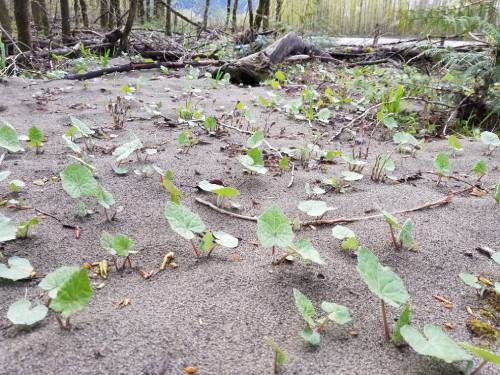Tussilago identification and control
Information about the noxious weed, Tussilago. Tussilago is also known by its Latin name, Tussilago farfara.
About this weed
European coltsfoot is a regulated Class B noxious weed in King County. This means control is required in King County under the state noxious weed law.
European coltsfoot is known as Tussilago farfara and it is in the aster family. Other common names include coltsfoot and bullsfoot.

Why it’s a problem
European coltsfoot tends to move into disturbed areas such as crop fields and riparian (river and stream edge) habitats. Where it then becomes dominant over other plant species. It thrives on disturbance to the point where it does better in a cultivated agricultural field than in a field that is left fallow. In Europe where the plant is native, it is still a troublesome weed in agricultural systems. This is especially true in organic farms, where it is extremely difficult to control once it becomes established.
In Washington European coltsfoot is often found in areas recently controlled for knotweed. It is concerning how thoroughly it can establish itself in riparian areas and wetlands.
European coltsfoot contains small amounts of toxic pyrrolizidine alkaloids. This can cause liver cancer or chronic liver disease.
Plant description
European coltsfoot is a clone-forming, rhizomatous (spreading root system that can grow new stems) perennial (plants that have a life cycle of 2 or more years) that grows to about 20 inches tall. Plants first send up flowering stems in the early spring. Each has a large, single yellow daisy-like flowerhead, with yellow ray and disk flowers, at stem tips.
Just before or after flowers have formed fluffy dandelion-like seeds, large basal leaves on long petioles (leaf stalks) grow up from the rhizomes. These leaves have somewhat roundish leaf blades that are more or less white and woolly on the undersides.
The leaf edges are often angled or squared off as if they were trimmed with scissors. Leaves tend to grow parallel to the ground.
European coltsfoot spreads through seed and the fragmentation of rhizomes. It grows best in disturbed areas such as agricultural fields or riparian areas.

.jpg?h=667&iar=0&w=500&rev=0357670b672d456cae798231e395cfec&hash=00D49900807F9480F1DBE71ADA551D92)
.jpg?h=667&iar=0&w=500&rev=e4a419b4ccbc40728fc9d1e7f8eaf8e5&hash=0B8E494578A26D0EF1BFCFD20310016D)

.jpg?h=375&iar=0&w=500&rev=16f1a4e703f94491a819fffe949bccf9&hash=0F14130BAE86BE2B6756285804ACF88C)
Be aware of look-alike plants
European coltsfoot is often confused with:
Taraxacum officinale, also known as common dandelion, is a perennial from a taproot. It only has leaves at the base of the flowering stem, at the same time it is flowering.
Petasites frigidus var. palmatus, also known as sweet coltsfoot, is a native rhizomatous perennial. It has a flowering stem of many white flowerheads that emerges before its lobed leaves grow from the ground.
Adenocaulon bicolor, also known as pathfinder, is a perennial from fibrous roots. It also has woolly leaf undersides, but it also has small, whitish flowers at top of its leafy stem.
When in doubt, take photos and share them with us or report them on iNaturalist.
What to do if you find it
Property owners are required to control European coltsfoot on lands that they manage. Please notify us if you see European coltsfoot growing in King County. Our program staff can provide you with site-specific advice on how best to remove it. We map all known locations of regulated noxious weeds to help locate new infestations in time to control them.
Control methods
We recommend using a combination of methods to control noxious weeds. In areas with few weeds, it is important to act quickly before they become harder to control. Make a long-term plan as it often takes several years to get rid of most weeds. Start in the least infested areas first and then move into more heavily infested areas.
Minimize soil disturbance during management, as European coltsfoot thrives in disturbed areas. When possible, control while pollinators are not active on plants. Boot brushing and general cleaning of clothing and tools is especially important to not further the spread of this species. Also, this plant is known to spread in contaminated fill materials so watch for new growth where fill has been used.
Manual control
Small infestations or young plants may be removed by carefully digging them out of the ground. However, as European coltsfoot is spread effectively by rhizomes (root system that spreads outwards and can grow new stems) this method may have limited use. Small fragments of the rhizomes can quickly resprout and reestablish the patch. The area must be revisited several times in one season to remove any resprouts.
Cultural control
Competitive perennial plants can reduce European coltsfoot populations. This can have the added benefit of replacing the coltsfoot as a food source for pollinators.
Chemical control
Stay safe when using herbicide:
- Always read the label before use.
- Wear a long-sleeved shirt, long pants, shoes, and eye protection.
- Follow state and local regulations.
Herbicide can be effective with a medium to large size infestation.
See the PNW Pest Management Handbook for the most up to date and specific method for chemical control of European coltsfoot.
Avoid spraying where there is a chance that herbicide will enter a waterway or wetland unless you are using a state-approved aquatic herbicide and have the required permits and licenses to do so. Use of pesticides in water is regulated in Washington state. See Washington Department of Ecology Aquatic Pesticide Permits for details.
For more information or a site-specific recommendation in King County, contact the noxious weed program. For information in other locations, contact your local weed board or extension office.
Disposal instructions
The rhizomes and seeds should be sealed in a bag and disposed of in the garbage. The rest of the plant may be composted.
Noxious Weed Disposal - Washington State Noxious Weed Control Board

 Translate
Translate